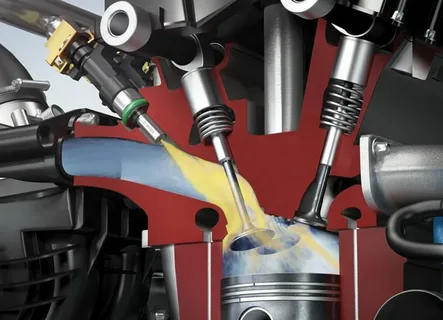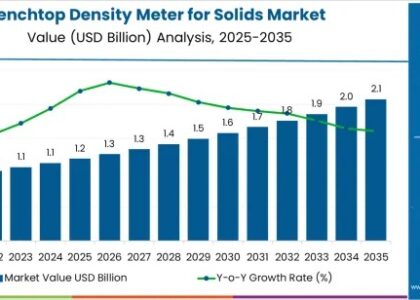The gasoline direct injection market valued at USD 12.63 billion in 2025, is projected to grow to USD 30.21 billion by 2035, with a striking CAGR of 9.1% during the said period. The reasonably good growth curve implies that GDI systems are steadily adopted in the automotive industry as a prime solution for improving engine performance, optimizing fuel combustion, and decreasing environmental impact.
As the automotive industry continues to navigate the crossroads of efficiency, performance, and environmental responsibility, Gasoline Direct Injection (GDI) technology has emerged as a game-changer in internal combustion engine design. Offering enhanced power output, improved fuel efficiency, and reduced emissions, GDI systems are redefining how gasoline engines operate in a world demanding cleaner and more responsive mobility.
Once reserved for high-performance applications, GDI has now become a foundational technology in modern passenger vehicles—bridging the gap between conventional combustion engines and the evolving landscape of hybrid and electric powertrains.
Get Ahead with Our Report: Request Your Sample Now!
https://www.futuremarketinsights.com/reports/sample/rep-gb-5264
Beyond the Intake: The Mechanics of Direct Injection
Traditional gasoline engines use port fuel injection, where fuel is mixed with air before entering the combustion chamber. GDI takes a more refined approach—injecting fuel directly into the combustion chamber under high pressure. This allows for more precise fuel delivery, improved atomization, and optimized combustion timing.
The result is a more efficient burn, translating to increased horsepower, torque, and fuel economy—all while helping automakers meet stringent emission regulations without compromising on performance.
High Performance Meets High Efficiency
One of the key advantages of GDI lies in its ability to offer enhanced engine responsiveness. With direct control over the fuel-air mixture, combustion becomes more dynamic and adaptable to changing driving conditions. This supports both spirited driving and everyday efficiency—an ideal blend for modern consumers who expect performance without excess consumption.
Additionally, GDI enables lean burn operations, stratified charge combustion, and faster throttle response, making it an ideal fit for turbocharged engines, downsized engine architectures, and hybrid systems seeking thermal efficiency.
Environmental Compliance and Emission Reduction
As governments and regulators push for lower carbon footprints, GDI systems provide a valuable tool for reducing CO₂ and other harmful emissions. More complete combustion means less fuel waste and cleaner exhaust gases.
To further enhance emission control, GDI systems are often paired with technologies such as exhaust gas recirculation (EGR), particulate filters, and advanced catalytic converters—ensuring compliance with the latest emission norms while preserving driving enjoyment.
Smart Integration with Engine Management Systems
GDI technology is no longer a standalone component—it’s deeply integrated with advanced engine management systems. These systems leverage real-time data to regulate injection timing, pressure, and spray patterns, adapting to load, temperature, and environmental conditions.
With the rise of smart vehicles, GDI systems are now embedded into broader ecosystems involving turbocharging, start-stop systems, and even hybrid-electric drivetrain coordination. This holistic integration enhances engine performance across scenarios while supporting the shift toward more connected and intelligent powertrains.
Applications Across Segments and Vehicle Types
While initially popularized in performance sedans and sports cars, GDI is now standard across a wide array of vehicle categories—from compact hatchbacks to SUVs, crossovers, and even light-duty trucks. Its versatility, scalability, and compatibility with turbocharged and hybrid platforms make it an essential component for manufacturers striving to deliver power, efficiency, and compliance in a competitive market.
In hybrid and plug-in hybrid electric vehicles (PHEVs), GDI plays a key role in optimizing engine operation during transitions between electric and gasoline power, helping maintain seamless performance and fuel economy.
Addressing Challenges: Carbon Buildup and Particulate Emissions
Despite its many advantages, GDI systems are not without challenges. One of the most notable issues is carbon buildup on intake valves, due to the absence of fuel wash typically seen in port-injected engines. This can lead to performance degradation and maintenance concerns over time.
Furthermore, while GDI reduces CO₂ emissions, it can increase the formation of fine particulate matter. This has prompted the inclusion of gasoline particulate filters (GPFs) and other aftertreatment solutions to meet tightening air quality standards.
Ongoing innovations in fuel injector design, dual-injection systems (combining port and direct injection), and improved engine oils are helping address these challenges and improve long-term reliability.
Exhaustive Market Report: A Complete Study
https://www.futuremarketinsights.com/reports/gasoline-direct-injection-gdi-market
A Core Technology for the Transition Era
As the automotive industry moves toward electrification, GDI continues to play a vital role—especially in hybrid systems and markets where full electric adoption is still emerging. Its ability to deliver fuel economy gains and reduce emissions without a complete departure from internal combustion makes it a strategic bridge technology for the transition period.
GDI also supports the development of synthetic fuels and biofuels, offering a path toward carbon-neutral combustion engines for future mobility ecosystems.
Looking Ahead: Smarter, Cleaner, More Efficient
The future of Gasoline Direct Injection lies in continuous refinement and innovation. Advanced materials, higher injection pressures, AI-driven combustion control, and real-time diagnostics are all on the horizon. These developments will further enhance engine efficiency, emissions compliance, and reliability—ensuring GDI remains relevant in a changing automotive landscape.
As the demand for cleaner, more powerful, and more efficient vehicles grows, GDI stands out as a vital enabler of next-generation mobility—delivering precision under pressure and performance without compromise.






